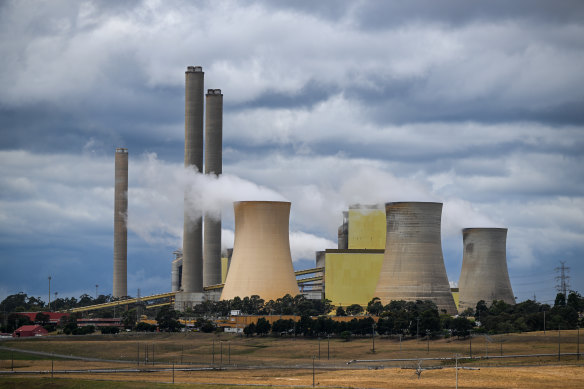
The Loy Yang power station in the Latrobe Valley.Credit: Joe Armao
If AGL were to align with a maximum of 1.5 degrees, it would be compelled to exit coal by as early as 2028-29, according to the company’s calculations. AGL chair Patricia McKenzie has repeatedly insisted she believes that such a timeframe would not achievable while ensuring power supply remains reliable and affordable.
Australia is experiencing one of the world’s fastest energy transitions as coal-fired power stations, which supply about two-thirds of the main grid, increasingly bring forward their closure dates while renewable energy’s share of the mix rapidly rises.
However, some power industry leaders and the Australian Energy Market Operator are increasingly nervous about the lagging pace of the rollout of new generation and storage projects required to compensate for coal plants’ withdrawals and meet the federal government’s 2030 renewable energy targets.
There are also concerns that the build-out of more than 10,000 kilometres of high-voltage transmission lines, which will be needed to link up new renewable energy zones and facilitate the flow of clean electrons from one part of the country to another, is happening too slowly, amid funding issues and local community opposition.
Loading
Speaking at the Australian Energy Week conference in Melbourne, Daniel Westerman, chief executive of the Australian Energy Market Operator, renewed calls for investors to accelerate financial commitments for new generation projects.
“Bringing these new projects to market and connecting them into the grid urgently is critical to ensure consumers continue to have reliable power when they need it,” he said. “Investment is not happening fast enough.”
There are encouraging signs, however, of the private sector’s increasing ambition to invest more heavily in the transition. Canadian asset giant Brookfield, which has struck a deal to acquire Origin’s domestic energy business, has pledged to spend as much as $30 billion rolling out large-scale renewable energy by 2033.
AGL, meanwhile, intends to spend as much as $20 billion to dramatically increase its portfolio of renewable energy from 1.7 gigawatts to 8 gigawatts by 2035. It would also seek to lift its “firming” capacity from 1.4 gigawatts to 7.3 gigawatts over that period.
Of its targeted 12 gigawatts of new firmed renewables capacity, AGL would fund 5.5 gigawatts from its own balance sheet, while the other 6.5 gigawatts would be funded through joint-venture partnerships and power-purchase agreements, chief executive Damien Nicks said.
“This is the biggest transition that this market has ever seen in terms of what we are doing over the next 12 years,” he said.
The Business Briefing newsletter delivers major stories, exclusive coverage and expert opinion. Sign up to get it every weekday morning.
Stay connected with us on social media platform for instant update click here to join our Twitter, & Facebook
We are now on Telegram. Click here to join our channel (@TechiUpdate) and stay updated with the latest Technology headlines.
For all the latest Business News Click Here
For the latest news and updates, follow us on Google News.
